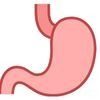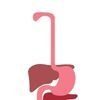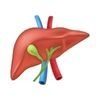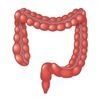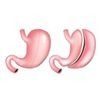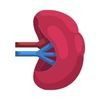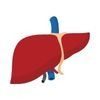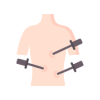Disease Information
All the major organs of our body are found inside the stomach. The stomach is a muscular bag of organs located just above the upper abdomen. Once any food or liquid enters the mouth, it is pushed down a narrow, muscular pipe-like structure called the esophagus. The end of the esophagus is conjoined to the stomach. The food/liquid is pushed through the esophagus into the stomach where the digestion process takes place. The stomach releases acids and enzymes while churning the food as part of the digestion process. The stomach is part of the Gastrointestinal tract.
The most common stomach diseases are Peptic ulcer, gastritis, Gastroesophageal Disease (GERD), Gastritis, Celiac disease, stomach flu, Irritable Bowel Syndrome (IBS), Crohn’s Disease, Colitis, Inflammatory Bowel Disease (IBD), Constipation, Hemorrhoids, Gallstones, Diverticular disease and cancer. Symptoms that indicate stomach disorders are bloating, bleeding, heartburn, diarrhea, constipation, pain in the stomach, nausea and vomiting.
Esophagus is a muscular hollow pipe-like structure that carries food and liquid from your mouth to your stomach. Part of the gastrointestinal tract, esophagus is responsible for propelling liquids and food by squeezing them in a wave-like movement. It is also referred to as the ‘food pipe’.
There are a group of conditions that affects the normal functioning of the esophagus and are called esophagal disorders. Dysphagia, meaning – trouble swallowing, is the most common symptom of many esophagal disorders.
One of the most common esophagal disorders is GERD (Gastrointestinal Reflux Disease) where stomach acids and other elements are forced back into the esophagus. This happens when the lower esophagal sphincter doesn’t close properly. Other esopghagal disorders are Achalasia, Barret’s esophagus, Esophagal Cancer, Esophagitis, Esophagal Varicies, Esophagal diverticulum, etc.
Part of the digestive system, the Small bowel connects the stomach with the larger intestine. The small bowel is the longest part of the digestive system. It is responsible for the absorption of nutrients and water that the body needs for proper functioning. Since this is the organ that absorbs nutrients, its disorders or malfunctioning can not only cause nutritional disorders but may also lead to malfunctioning of other body organs and can cause significant discomfort.
It can be affected by obstruction, stricture, infection and cancer. The symptoms of small bowel disorders are often none and go unnoticed most of the time. However, sometimes some symptoms do show up like bloating, constipation, gas, nausea, abdominal pain, abdominal discomfort and diarrhea depending upon the disorder. Causes leading to small bowel disorders are different, depending upon the disorder and in some cases, the causes remain unknown.
The gallbladder is a small organ located just beneath the liver. It works in sync with the liver and stores bile produced by the liver. Bile is required to break down the fats consumed by us into fatty acids. The bile is continuously produced by the liver which is then stored in the gallbladder. When the food reaches the esophagus and stomach, the bile from the gallbladder is released into the intestine to aid food digestion.
The most common ailment affecting the gallbladder is gallstones. These gallstones are usually present in the gallbladder of every individual and are considered harmless but may lead to extreme discomfort and pain in severe conditions. Other gallbladder disorders include Cholecystitis, pancreatitis and gallbladder cancer.
Symptoms that tell you that there is something wrong with your gallbladder include some conditions like jaundice, infection, pus, etc and are characterized by abdominal pain in the upper or midsection or, sometimes, in the right shoulder or back, nausea, vomiting, fever with chills or only chills.
The colon and rectum are part of the large intestine and are part of the digestive tract, sometimes also known as the gastrointestinal tract. It is the job of the colon to remove water, nutrients and electrolytes from the digested food received from the small intestine. The colon slowly moves the remaining undigested food, also referred to as solid waste, along the muscular tube and into the rectum where it is stored. This solid waste is then thrown out of the body through the rectum.
The common disorders relating to both the colon and the rectum are infection and cancer. Triggers that could lead to an unhealthy colon and rectum are foods with high fats, high sugar, eating great amounts of meat, drinking alcohol, smoking or being obese. Other disorders include constipation, Irritable Bowel Syndrome, fissures, polyps, colitis, abscess and haemorrhoids.
Bariatric Surgery is the surgical solution for weight loss when nothing seems to be working for weight loss and the patient is having trouble living a normal life because of being obese. This surgery is usually opted when all other weight loss methods like dieting and exercising do not work and the weight creates medical problems in the patient’s life. Bariatric surgery involves making changes in the digestive system to help lose weight by either limiting the amount of food the patient can eat or by limiting the absorption of nutrients or both, depending upon the type of bariatric surgery.
There are different types of bariatric surgeries like gastric bypass, gastric banding, etc.; all done for the same goal of losing weight. Bariatric surgery proves helpful in treating many medical conditions like diabetes –type 2 or thyroid and is clubbed under ‘Major Surgery’. Bariatric surgery is performed for treating medical conditions rather than for cosmetic reasons.
The organs involved in the production, storage and transportation of bile fall under the Biliary Tract section viz a viz liver, gallbladder, pancreas and bile ducts. Any condition that disrupts the normal functioning of these organs is referred to as Biliary Tract disorder. The biliary tract is also known as the biliary tree or the biliary system.
Common conditions affecting the biliary tract are gallstones – a condition in which small stones like structures are formed consisting of calcium salts, bile pigments and cholesterol that block the path of bile transportation from the gallbladder; bile duct obstruction – a condition in which the gallstones that got released from the gallbladder obstruct the bile ducts; and biliary colic – a condition that is caused by a temporary obstruction in the cystic duct. The symptoms of all these orders are much similar and are categorized as mild to severe upper abdominal pains.
The Spleen is about the size of a fist and is situated just under the ribcage on the left side of the stomach. It is responsible for producing the antibodies (white blood cells) that help in fighting infection, filter the blood and keep the fluids in the body in a balanced ratio.
An enlarged spleen disorder, termed splenomegaly, is usually not a disease. Instead, it is a symptom of other medical conditions affecting the body. Causes that lead to splenomegaly are many including hemolytic anaemia, infections (viral, bacterial or fungal), metabolic diseases, liver diseases, blood clots in the veins of the liver or spleen, different types of cancer, felty syndrome and many more.
Symptoms usually include not being able to eat fully or being able to eat only in small amounts, dull pain in the upper left side of the abdomen or the back or becoming anaemic.
Although the Liver is the largest solid organ of the body, it is also referred to as a Gland because it produces chemicals (bile) that are needed for the digestion of food. Apart from this, the liver also performs other important functions of the body like controlling metabolism which helps in synthesising proteins, fats and carbohydrates, cleans the blood of toxins and old red blood cells, regulates blood clotting and stores glycogen and vitamins for later use.
Some of the common disorders affecting the liver that hinder its normal functioning are fatty liver disease – a condition that happens when too many fats are consumed by the patient; Cirrhosis – a condition that damages the liver tissue and is caused by either too much alcohol or too many toxins; viral infections such as Hepatitis A, B and C; Liver Cancer; autoimmune diseases; and inherited liver diseases such as hemochromatosis or Wilson disease.
The most common symptom of a liver disorder is jaundice – the yellowing of skin, nails and whites of the eyes.
This organ of the digestive system is responsible for the hormones that control the amount of sugar in the blood and produce enzymes that help in the digestion of food. The pancreas is an organ but is considered to be a gland since it produces and releases enzymes and hormones needed for the body to function normally.
Common conditions of the pancreas that a person can suffer from are diabetes Type 1 and Type 2, hyperglycemia – a disorder in which the pancreas produces too much glucagon resulting in high levels of sugar in the bloodstream; hypoglycemia – a disorder in which the pancreas produces too much of insulin resulting in low level of sugar in the bloodstream; pancreatitis – a disease in which your pancreas becomes inflamed; and Pancreatic cancer – considered rare and is not easily detected in its early stages due to lack of symptoms. At a later stage, however, pancreatic cancer does not have any specific symptoms but is characterized by a sudden lack of appetite and weight loss.
Cancer of the Gastrointestinal Tract, Liver, Pancreas and Biliary System is referred to as GI and HPB cancer. Because of the positions of these organs in the body, tumours are usually missed by doctors. Detecting the HPB cancer needs specialized tests like Endoscopic ultrasound, Spy scopy, Multi-slice CT Scan, MRCP – Magnetic resonance cholangiopancreatography and ERCP – endoscopic cholangiopancreatography. This cancer does not have specific symptoms and needs a high degree of suspicion and expertise to be diagnosed.
There are various treatments available for this cancer that, if given at the right time, can help the patient in living a normal life. However, these cancers are usually diagnosed at a very late stage.
Hernia is a bulge of an organ that has pushed through the muscle or tissue that holds it in its place. Hernias do not heal on their own since they occur due to pressure on a specific organ and the weakness of tissue or muscle along its side. If left untreated, they get bigger and may lead to serious health issues.
The most common type of hernia is when the intestines push through the lower abdominal wall, referred to as Inguinal Hernia. When the stomach pushes through a part of the diaphragm and into the chest cavity, it is called Hiatal Hernia. Hernias can also affect babies and children.
This type of hernia is called Umbilical Hernia and is characterized by a bulge when the intestines push through the abdominal wall near the belly button. Ventral Hernia is caused by obesity, pregnancy, heavy and strenuous activity or can be present by birth as well.
Surgery is the only option available to treat hernias.
Are you in need of a surgical procedure that can help you heal faster along with the utmost precision and care? Have you considered laparoscopic surgery instead of the traditional one? Then let us hear from the best laparoscopic surgeon in Surat, about it.
Laparoscopic surgery can be opted for a range of medical conditions and procedures that can benefit from minimally invasive techniques. Typically, this option is suitable for those seeking reduced scarring, faster recovery times, and less postoperative pain. However, the appropriateness of laparoscopic surgery depends on the specific condition, the patient’s overall health, and the surgeon’s expertise. It’s essential to consult with a qualified laparoscopic surgeon in Surat to determine if laparoscopic surgery is the right choice for your particular medical situation.
Dr. Dhaval Mangukiya is one of the best laparoscopic surgeons in Surat and is dedicated to delivering comprehensive solutions through this innovative surgical approach. With his extensive expertise and unwavering commitment to patient well-being, Dr. Dhaval Mangukiya is your trusted partner in achieving the best possible outcomes for your medical needs.

